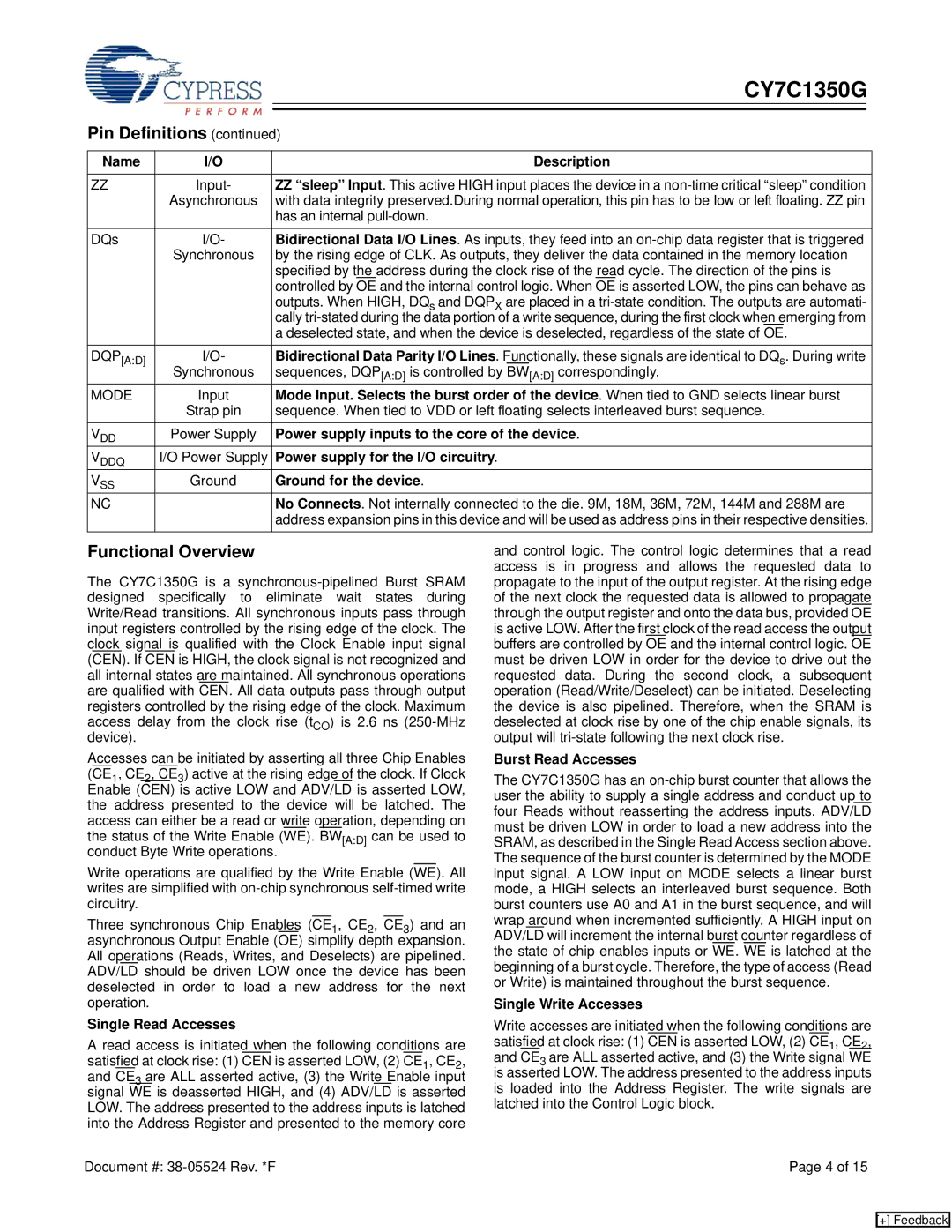
|
|
| CY7C1350G | |
|
|
| ||
|
|
|
|
|
|
|
|
| |
Pin Definitions (continued) | ||||
|
|
| ||
Name | I/O | Description | ||
|
|
| ||
ZZ | Input- | ZZ “sleep” Input. This active HIGH input places the device in a | ||
| Asynchronous | with data integrity preserved.During normal operation, this pin has to be low or left floating. ZZ pin | ||
|
|
| has an internal | |
DQs | I/O- | Bidirectional Data I/O Lines. As inputs, they feed into an | ||
| Synchronous | by the rising edge of CLK. As outputs, they deliver the data contained in the memory location | ||
|
|
| specified by the address during the clock rise of the read cycle. The direction of the pins is | |
|
|
| controlled by OE and the internal control logic. When OE is asserted LOW, the pins can behave as | |
|
|
| outputs. When HIGH, DQs and DQPX are placed in a | |
|
|
| cally | |
|
|
| a deselected state, and when the device is deselected, regardless of the state of OE. | |
DQP[A:D] | I/O- | Bidirectional Data Parity I/O Lines. Functionally, these signals are identical to DQs. During write | ||
| Synchronous | sequences, DQP[A:D] is controlled by BW[A:D] correspondingly. | ||
MODE | Input | Mode Input. Selects the burst order of the device. When tied to GND selects linear burst | ||
| Strap pin | sequence. When tied to VDD or left floating selects interleaved burst sequence. | ||
VDD | Power Supply | Power supply inputs to the core of the device. | ||
VDDQ | I/O Power Supply | Power supply for the I/O circuitry. | ||
VSS | Ground | Ground for the device. | ||
NC |
|
| No Connects. Not internally connected to the die. 9M, 18M, 36M, 72M, 144M and 288M are | |
|
|
| address expansion pins in this device and will be used as address pins in their respective densities. | |
Functional Overview
The CY7C1350G is a
Accesses can be initiated by asserting all three Chip Enables (CE1, CE2, CE3) active at the rising edge of the clock. If Clock Enable (CEN) is active LOW and ADV/LD is asserted LOW, the address presented to the device will be latched. The access can either be a read or write operation, depending on the status of the Write Enable (WE). BW[A:D] can be used to conduct Byte Write operations.
Write operations are qualified by the Write Enable (WE). All writes are simplified with
Three synchronous Chip Enables (CE1, CE2, CE3) and an asynchronous Output Enable (OE) simplify depth expansion. All operations (Reads, Writes, and Deselects) are pipelined. ADV/LD should be driven LOW once the device has been deselected in order to load a new address for the next operation.
Single Read Accesses
A read access is initiated when the following conditions are satisfied at clock rise: (1) CEN is asserted LOW, (2) CE1, CE2, and CE3 are ALL asserted active, (3) the Write Enable input signal WE is deasserted HIGH, and (4) ADV/LD is asserted LOW. The address presented to the address inputs is latched into the Address Register and presented to the memory core
and control logic. The control logic determines that a read access is in progress and allows the requested data to propagate to the input of the output register. At the rising edge of the next clock the requested data is allowed to propagate through the output register and onto the data bus, provided OE is active LOW. After the first clock of the read access the output buffers are controlled by OE and the internal control logic. OE must be driven LOW in order for the device to drive out the requested data. During the second clock, a subsequent operation (Read/Write/Deselect) can be initiated. Deselecting the device is also pipelined. Therefore, when the SRAM is deselected at clock rise by one of the chip enable signals, its output will
Burst Read Accesses
The CY7C1350G has an
Single Write Accesses
Write accesses are initiated when the following conditions are satisfied at clock rise: (1) CEN is asserted LOW, (2) CE1, CE2, and CE3 are ALL asserted active, and (3) the Write signal WE is asserted LOW. The address presented to the address inputs is loaded into the Address Register. The write signals are latched into the Control Logic block.
Document #: | Page 4 of 15 |
[+] Feedback
